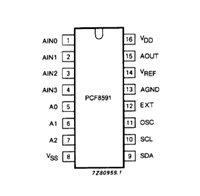AD808
TH EO RY O F O P ERATIO N
Q uantizer
1
S
⌽
DATA
INPUT
S + 1
DET
⌺
T he quantizer (comparator) has three gain stages, providing a
net gain of 350. T he quantizer takes full advantage of the Extra
Fast Complementary Bipolar (XFCB) process. T he input stage
uses a folded cascode architecture to virtually eliminate pulse
width distortion, and to handle input signals with common-
mode voltage as high as the positive supply. T he input offset
voltage is factory trimmed and is typically less than 1 mV. XFCB’s
dielectric isolation allows the different blocks within this mixed-
signal IC to be isolated from each other, hence the 4 mV Sensi-
tivity is achieved. T raditionally, high speed comparators are
plagued by crosstalk between outputs and inputs, often resulting
in oscillations when the input signal approaches 10 mV. T he
AD808 quantizer toggles at 2 mV (4.0 mV sensitivity) at the
input without making bit errors. When the input signal is low-
ered below 2 mV, circuit performance is dominated by input
noise, and not crosstalk.
VCO
F
RECOVERED CLOCK
OUTPUT
DET
RETIMING
DEVICE
RETIMED DATA
OUTPUT
Figure 12. PLL Block Diagram
T he frequency detector delivers pulses of current to the charge
pump to either raise or lower the frequency of the VCO. During
the frequency acquisition process the frequency detector output
is a series of pulses of width equal to the period of the VCO.
T hese pulses occur on the cycle slips between the data fre-
quency and the VCO frequency. With a maximum density data
pattern (1010 . . . ), every cycle slip will produce a pulse at the
frequency detector output. However, with random data, not
every cycle slip produces a pulse. T he density of pulses at the
frequency detector output increases with the density of data
transitions. T he probability that a cycle slip will produce a pulse
increases as the frequency error approaches zero. After the fre-
quency error has been reduced to zero, the frequency detector
output will have no further pulses. At this point the PLL begins
the process of phase acquisition, with a settling time of roughly
2000 bit periods.
Signal D etect
T he input to the signal detect circuit is taken from the first stage
of the quantizer. T he input signal is first processed through a
gain stage. T he output from the gain stage is fed to both a posi-
tive and a negative peak detector. T he threshold value is sub-
tracted from the positive peak signal and added to the negative
peak signal. T he positive and negative peak signals are then
compared. If the positive peak, POS, is more positive than the
negative peak, NEG, the signal amplitude is greater than the
threshold, and the output, SDOUT , will indicate the presence
of signal by remaining low. When POS becomes more negative
than NEG, the signal amplitude has fallen below the threshold,
and SDOUT will indicate a loss of signal (LOS) by going high.
T he circuit provides hysteresis by adjusting the threshold level
higher by a factor of two when the low signal level is detected.
T his means that the input data amplitude needs to reach twice
the set LOS threshold before SDOUT will signal that the data is
again valid. T his corresponds to a 3 dB optical hysteresis.
Jitter caused by variations of density of data transitions (pattern
jitter) is virtually eliminated by use of a new phase detector
(patented). Briefly, the measurement of zero phase error does
not cause the VCO phase to increase to above the average run
rate set by the data frequency. T he jitter created by a 27–1 pseu-
dorandom code is 1/2 degree, and this is small compared to
random jitter.
T he jitter bandwidth for the PLL is 0.06% of the center fre-
quency. T his figure is chosen so that sinusoidal input jitter at
350 Hz will be attenuated by 3 dB.
T he damping ratio of the PLL is user programmable with a
single external capacitor. At 622 MHz, a damping ratio of 5 is
obtained with a 0.47 µF capacitor. More generally, the damping
THRESHOLD
AD808
BIAS
PIN
IHYS
COMPARATOR STAGES
& CLOCK RECOVERY PLL
+
ratio scales as (fDAT A × CD)1/2
.
+
NIN
ITHR
A lower damping ratio allows a faster frequency acquisition;
generally the acquisition time scales directly with the capacitor
value. However, at damping ratios approaching one, the acquisi-
tion time no longer scales directly with capacitor value. T he
acquisition time has two components: frequency acquisition and
phase acquisition. T he frequency acquisition always scales with
capacitance, but the phase acquisition is set by the loop band-
width of the PLL and is independent of the damping ratio. In
practice the acquisition time is dominated by the frequency
acquisition. T he fractional loop bandwidth of 0.06% should
give an acquisition time of 2000 bit periods. H owever, the
actual acquisition time is several million bit periods and is
comprised mostly of the time needed to slew the voltage on
the damping capacitor to final value.
POSITIVE
PEAK
DETECTOR
LEVEL
SHIFT
DOWN
SDOUT
NEGATIVE
PEAK
DETECTOR
LEVEL
SHIFT
UP
Figure 11. Signal Level Detect Circuit Block Diagram
P hase-Locked Loop
T he phase-locked loop recovers clock and retimes data from
NRZ data. T he architecture uses a frequency detector to aid
initial frequency acquisition; refer to Figure 12 for a block dia-
gram. Note the frequency detector is always in the circuit. When
the PLL is locked, the frequency error is zero and the frequency
detector has no further effect. Since the frequency detector is
always in the circuit, no control functions are needed to initiate
acquisition or change mode after acquisition.
REV. 0
–7–






 STM32F030C6芯片介绍:主要参数分析、引脚配置说明、功耗及封装
STM32F030C6芯片介绍:主要参数分析、引脚配置说明、功耗及封装

 PCF8591数据手册解读:参数、引脚说明
PCF8591数据手册解读:参数、引脚说明

 一文带你了解ss8050参数、引脚配置、应用指南
一文带你了解ss8050参数、引脚配置、应用指南

 深入解析AD7606高性能多通道模数转换器:资料手册参数分析
深入解析AD7606高性能多通道模数转换器:资料手册参数分析
